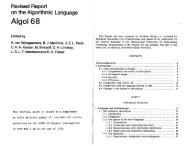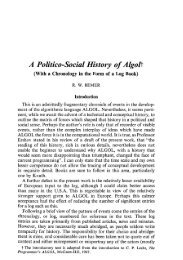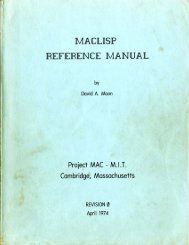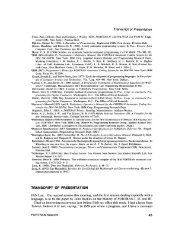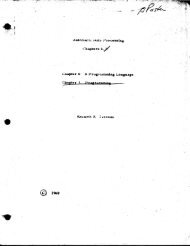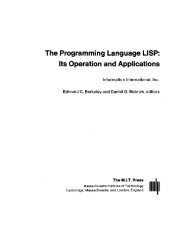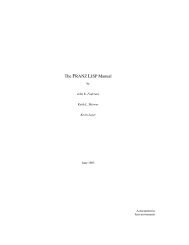LISP I Programmer's Manual - Software Preservation Group
LISP I Programmer's Manual - Software Preservation Group
LISP I Programmer's Manual - Software Preservation Group
You also want an ePaper? Increase the reach of your titles
YUMPU automatically turns print PDFs into web optimized ePapers that Google loves.
Running a <strong>LISP</strong> ProgramIn this section, various aspects of running a <strong>LISP</strong> programare discussed. In Section 5.1, we discuss how to punch cards,put together a running deck, and submit a run. In Section 5.2,the tracing program is described. Section 5.3 encompasses abrief discussion of the current state of the <strong>LISP</strong>-Flexo system.The error indications given by the <strong>LISP</strong> I system when runninga <strong>LISP</strong> program have been relegated to a late section (chapter 8)since they are in the nature of a reference look-up list.5.1 Submitting a RunAs stated in the previous section, the foundation of <strong>LISP</strong>programming is the APPLY operator, which is based on the functionapply[f;x;p]. The function f must have been defined by thedefine function or by one of the other ways mentioned previously.A <strong>LISP</strong> program consists of sets of triplets, f;x;p, which arepunched on cards and submitted in the appropriate order in adeck,Card PunchingColumns 1-72 (inclusive) of a punched card are read by the<strong>LISP</strong> read program. The S-expression for the 2, 5, and - p of eachtriplet should be punched on cards with one or more spaces (blanks)between each member of the triplet. There are no rules about thelocation of the expression on the card; a new card may be startedat any point in an expression, and the punching on a given cardmay stop at any column before column 73. In other words, cardboundaries are ignored. The read program reads until it finds




